https://sputnikglobe.com/20231209/a-5300-year-old-rice-paddy-unearthed-in-chinas-zhejiang-province-1115494424.html
A 5300-Year-Old Rice Paddy Unearthed in China's Zhejiang Province
A 5300-Year-Old Rice Paddy Unearthed in China's Zhejiang Province
Sputnik International
Archaeologists have unearthed a 1,000-square-meter site in Ningbo's Hemudu culture zone, revealing an ancient, sophisticated irrigation system, remnants of rice cultivation, and evidence of residential connectivity in the lower Yangtze River region.
2023-12-09T14:27+0000
2023-12-09T14:27+0000
2023-12-09T14:27+0000
beyond politics
ningbo
zhejiang province
east
newsfeed
china
https://cdn1.img.sputnikglobe.com/img/102789/41/1027894123_0:161:3071:1888_1920x0_80_0_0_ccc2388971347fb37c4d7c1e287f8a98.jpg
A recent archaeological discovery in Zhejiang Province, East China, has unveiled an ancient rice paddy dating back approximately 5,300 to 5,500 years, according to a news source.The find, encompassing approximately 1,000 square meters, has been made in the heart of the Neolithic-era Hemudu culture zone, a central site of ancient human activity, as reported by the Ningbo Municipal Research Academy of Cultural Heritage Management.During the excavation, archaeologists uncovered three ridges, nine pits, and traces of rice and weeds. They also discovered an irrigation and drainage system and a path that connected the rice field to neighboring homes.Studies indicate that the pits were the result of previous renovations to the surrounding ridges and ditch. The discovery reveals a comprehensive ancient rice farming system, offering crucial insights into the agricultural techniques practiced in the region's plains.The Hemudu culture, originating from Ningbo's Hemudu Township, was an ancient civilization noted for its rice farming advancements and unique elevated buildings. The society flourished in the lower Yangtze River area.In December 2020, Chinese media reported that archaeologists had discovered the world's oldest rice paddies in Yuyao, Zhejiang Province, China, dating back about 6,300 years. Located in the Shi'ao Ruins, near the Hemudu Site, these prehistoric paddies cover an area of around 900,000 square meters, with 7,000 square meters currently excavated.The site shows an elaborate arrangement of grid-patterned paddies with roads and irrigation, dating back to the Liangzhu Culture era (2,900-2,500 BC), underscoring the significance of rice farming in early Chinese societies like Hemudu and Liangzhu.
https://sputnikglobe.com/20220223/china-finds-way-to-fight-starvation-with-sea-water-rice-1093305380.html
ningbo
zhejiang province
east
china
Sputnik International
feedback@sputniknews.com
+74956456601
MIA „Rossiya Segodnya“
2023
Chimauchem Nwosu
https://cdn1.img.sputnikglobe.com/img/07e7/09/01/1113046371_0:99:1536:1635_100x100_80_0_0_9c5c627283eca931c39fe4852bbb301c.jpg
Chimauchem Nwosu
https://cdn1.img.sputnikglobe.com/img/07e7/09/01/1113046371_0:99:1536:1635_100x100_80_0_0_9c5c627283eca931c39fe4852bbb301c.jpg
News
en_EN
Sputnik International
feedback@sputniknews.com
+74956456601
MIA „Rossiya Segodnya“
Sputnik International
feedback@sputniknews.com
+74956456601
MIA „Rossiya Segodnya“
Chimauchem Nwosu
https://cdn1.img.sputnikglobe.com/img/07e7/09/01/1113046371_0:99:1536:1635_100x100_80_0_0_9c5c627283eca931c39fe4852bbb301c.jpg
zhejiang province, east china, ancient rice paddy, neolithic era, hemudu culture, ningbo municipal research academy, cultural heritage management, archaeological excavation, rice, weeds, irrigation system, drainage system, agricultural techniques, plains, ningbo, hemudu township, ancient civilization, rice farming, elevated buildings, yangtze river, archaeological discovery, liangzhu culture era.
zhejiang province, east china, ancient rice paddy, neolithic era, hemudu culture, ningbo municipal research academy, cultural heritage management, archaeological excavation, rice, weeds, irrigation system, drainage system, agricultural techniques, plains, ningbo, hemudu township, ancient civilization, rice farming, elevated buildings, yangtze river, archaeological discovery, liangzhu culture era.
A 5300-Year-Old Rice Paddy Unearthed in China's Zhejiang Province
Archaeologists have unearthed a 1,000-square-meter site in Ningbo's Hemudu culture zone, revealing an ancient, sophisticated irrigation system, remnants of rice cultivation and evidence of residential connectivity in the lower Yangtze River region.
A recent archaeological discovery in Zhejiang Province, East China, has unveiled an ancient rice paddy dating back approximately 5,300 to 5,500 years, according to a news source.
The find, encompassing approximately 1,000 square meters, has been made in the heart of the Neolithic-era Hemudu culture zone, a central site of ancient human activity, as reported by the Ningbo Municipal Research Academy of Cultural Heritage Management.
During the excavation, archaeologists uncovered three ridges, nine pits, and
traces of rice and weeds. They also discovered an irrigation and drainage system and a path that connected the rice field to neighboring homes.

23 February 2022, 17:26 GMT
Studies indicate that the pits were the result of previous renovations to the surrounding ridges and ditch. The discovery reveals a comprehensive ancient rice farming system, offering crucial insights into the agricultural techniques practiced in the region's plains.
The Hemudu culture, originating from
Ningbo's Hemudu Township, was an ancient civilization noted for its
rice farming advancements and unique elevated buildings. The society flourished in the lower Yangtze River area.
In December 2020, Chinese media reported that archaeologists had discovered the world's oldest rice paddies in Yuyao, Zhejiang Province, China, dating back about 6,300 years. Located in the Shi'ao Ruins, near the Hemudu Site, these prehistoric paddies cover an area of around 900,000 square meters, with 7,000 square meters currently excavated.
The site shows an elaborate arrangement of grid-patterned paddies with roads and irrigation, dating back to the Liangzhu Culture era (2,900-2,500 BC), underscoring the significance of rice farming in early Chinese societies like Hemudu and Liangzhu.




